1. Background analysis of candidates in the Municipal elections 2017
In the following review, background information of persons entitled to vote and of the candidates nominated by the parties are examined. The data on persons entitled to vote derive from the voting register established on 22 February 2017 and the data on the candidates from the candidate register set up on 9 March 2017. The background data are based on statistical data from Statistics Finland, such as population, employment and family statistics and the Register of Completed Education and Degrees.
The candidates differ by age structure and sex from all persons entitled to vote. Considerably fewer of the candidates are aged 30 or under and 70 or over than the persons entitled to vote, and more of the candidates are men than women. This should be taken into consideration when comparing the candidates with persons entitled to vote. In the tables and figures of this analysis, the data are not age-standardised. Standardisation would slightly lower the difference between the candidates and those entitled to vote, for example, when comparing the level of education, main type of activity, family status and socio-economic group among the candidates and persons entitled to vote.
Only the parliamentary parties are specified in the following examination. The candidates nominated by other parties and constituency associations are presented as one category “Others”.
1.1. Summary
Number of candidates decreases, average age increasesThe number of candidates in the Municipal elections has been declining for a long time. Now, 33,618 candidates were nominated in the Municipal elections, which is 3,500 fewer than in 2012 and 6,100 fewer than in the 2000 elections. Only the Green League and the Christian Democrats in Finland were able to nominate more candidates than in the 2012 elections. Just like in previous years, the Centre Party of Finland has most candidates even though its number of the candidates has also declined from previous years.
The proportion of female candidates has remained at around 40 per cent already for a long time. Only the Green League has more female than male candidates. Around 58 per cent of its candidates are women. Among the parliamentary parties, the Finns Party has the least female candidates, 25 per cent.
Candidates are, on average, close on one year younger than persons entitled to vote The average age of the candidates has, however, risen faster than that of persons entitled to vote. Since 2000, the average age of the candidates has risen by 3.6 years. Over the same period, the average age of persons entitled to vote has risen by nearly three years.
One-half of the candidates were also candidates in the previous electionsAmong all the candidates nominated by the parties over one-half were also candidates in the 2012 Municipal elections, primarily as candidates for the same party. Since the last elections, the Green League has renewed its list of candidates the most, 60 per cent of their candidates were not candidates in the previous Municipal elections.
Around one-fifth of the candidates are current councillors. The Centre Party has the most current councillors on its list, around 28 per cent of the party's candidates. Altogether 162 of the candidates are Members of Parliament.
The Centre Party candidates dominate in small municipalities measured by population with fewer than 20,000 inhabitants. In municipalities with fewer than 5,000 inhabitants as many as 40 per cent of all candidates were nominated by the Centre Party. In the largest municipalities with over 100,000 inhabitants, the party distribution is clearly more even and no party has over 20 per cent of the candidates.
Persons with foreign background under-representedCompared with persons entitled to vote, persons with foreign background are under-represented among candidates. Persons of foreign background, that is, persons, whose both parents were born abroad, represent close on six per cent of those entitled to vote and slightly over two per cent of candidates. The highest proportions of candidates with foreign background were nominated by the Swedish People's Party (4.2%) and the least by the Centre Party (1.2%).
Examined by native language, the result is similar. Clearly fewer candidates than persons entitled to vote speak a foreign language as their native language. There are 727 foreign-language speaking candidates. The largest group of foreign-language speaking candidates is formed by Russian speakers, 164 candidates, and the second largest by Estonian speakers, 72 candidates.
There are citizens from over 60 different countries among the candidates, even though the share of foreign citizens among all candidates is under one per cent. Four per cent of all persons entitled to vote are foreign citizens. Of the candidates, 263 persons are foreign citizens. A person can have more than one nationality. There are 462 candidates that are Finnish citizens with citizenship in another country as well. They represent 1.4 per cent of all candidates. Among all persons entitled to vote, around 1.7 per cent have dual citizenship.
Candidates are more highly educated and more actively in working lifeAs regards education, candidates differ clearly from persons entitled to vote. Nearly 90 per cent of the candidates have completed post-comprehensive level qualifications while 73 per cent of those entitled to vote have done so. This is largely explained by the different age structure of people entitled to vote and the candidates. The educational level is highest for the Green League candidates. More than one-half of them have tertiary level qualifications, while this is so for one-third of all candidates and one fifth of all persons entitled to vote.
The difference in the age structure between the candidates and persons entitled to vote is also reflected in the difference between the labour market position of candidates and persons entitled to vote: nearly 70 per cent of candidates are employed and around one-half of those entitled to vote. Nearly 30 per cent of those entitled to vote are, in turn, retired, while this is the case for 17 per cent of candidates. The employment rate is calculated as the share of employed persons in working-age population aged 18 to 64. The employment rate of the candidates is 78 per cent, while that of persons entitled to vote is around ten percentage points lower.
Viewed by socio-economic group, there are more self-employed persons among the candidates than among persons entitled to vote. The share of self-employed persons among employed candidates is 16.5 per cent and 10.5 per cent among persons entitled to vote. Most self-employed persons are found among Centre Party candidates, nearly 30 per cent, of whom more than one-half are farmers and forestry entrepreneurs. Among Coalition Party candidates good one-fifth are also self-employed.
The local government sector employs candidates more than persons entitled to vote. Around 31 per cent of employed candidates work in the local government sector, while among those entitled to vote, 23 per cent work for a local authority. Wage and salary earners in the central government sector are candidates particularly in larger municipalities with over 100,000 inhabitants. In them, more than ten per cent of employed candidates work in the central government sector, while 6.5 per cent of all candidates and 5.8 per cent of persons entitled to vote work for the central government sector.
Good one-third of candidates live in a family with childrenThe candidates also differ in their family status from the persons entitled to vote: considerably more (36%) of candidates are parents of a family with children than among persons entitled to vote (23%). Less than 20 per cent of the candidates live alone, while around one-quarter of persons entitled to vote live alone. Differences in the family status are explained by the fact that the age structure of the candidates and persons entitled to vote differ from each other.
The current family status does not reveal how many of the candidates and of those entitled to vote have or have had children of their own. This can, however, be examined based on the number of children recorded in the Finnish Population Information System. Candidates have more children than average. Of the candidates, 78 per cent have children of their own, whereas the corresponding figure for persons entitled to vote is 65 per cent. The candidates have 2.0 children, on average, and persons entitled to vote have 1.5 children. The number of children is highest among Christian Democrats, 2.4 children and lowest among Green League candidates, 1.6 children.
Highest income level among Coalition Party candidatesCandidates are more highly educated and a larger share of them are also working. This also partially explains that the candidates’ income level is higher than that of persons entitled to vote. The median for disposable monetary income among candidates in 2015 was EUR 26,100, while that of all persons entitled to vote was EUR 5,600 lower. Disposable monetary income refers to the monetary income after taxes that consists of earned income, property income, and transfer income.
The candidates’ income varies by party from EUR 31,200 in the Coalition Party to EUR 22,200 in the Finns Party. When the population entitled to vote is arranged according to income and divided into ten equal parts, the income deciles of the population entitled to vote are generated. Each of these has slightly under 440,000 persons. The highest-income decile of the population entitled to vote has at least EUR 38,000 at their disposal and the lowest income decile at most EUR 8,250 per year.
Of all candidates, 18 per cent belong to the highest income decile. Of the candidates, those representing the Coalition Party and the Swedish People's Party belong to the higher end of the income distribution. Thirty-six per cent of the male candidates and 25 per cent of the female candidates in the National Coalition Party belong to the highest income decile. Among the candidates of the Swedish People's Party, around 34 per cent of men and 19 per cent of women belong to the highest income decile.
One-tenth of all persons entitled to vote thus belong to the lowest income decile. Of the candidates, slightly fewer, around six per cent, belong to this decile. Only among female candidates nominated by constituency associations and other parties over ten per cent belong to the lowest income decile. For other parties, the shares fluctuate between 2.6 and nine per cent.
1.2. Candidates and persons entitled to vote by sex
Green League and the Christian Democrats increased their number of candidatesA total of 33,618 candidates were nominated for the Municipal elections. This is 3,506 fewer candidates than in 2012. Nearly all parties have a lower number of candidates than in the previous Municipal elections. Only the Green League and the Christian Democrats were able to nominate more candidates than in the 2012 elections. In the 2012 elections, the Green League had 2,299 candidates, now in the 2017 elections three hundred more, that is, 2,600 candidates. The Christian Democrats increased their number of candidates by around one hundred. The number of candidates decreased most in the National Coalition Party both in terms of number and in relative terms. As in previous years, the Centre Party of Finland (7,461) had the most candidates, even though its number of candidates is also lower than in the previous election. (Table 1)
Table 1. Number of candidates by party in Municipal elections 2008, 2012 and 2017
| Party | Number of candidates | Change from the previous elections, % | |||
| 2008 | 2012 | 2017 | 2012 | 2017 | |
| Candidates total |
38,509 | 37,124 | 33,618 | -3.6 | -9.4 |
| Centre Party of Finland KESK |
9,977 | 8,401 | 7,461 | –15.8 | –11.2 |
| National Coalition Party KOK |
7,628 | 6,874 | 5,739 | –9.9 | –16.5 |
| Finns Party PS |
1,840 | 4,394 | 3,831 | 138.8 | -12.8 |
| Finnish Social Democratic Party SDP |
7,702 | 6,986 | 6,132 | -9.3 | -12.2 |
| Green League VIHR |
2,192 | 2,299 | 2,600 | 4.9 | 13.1 |
| Left Alliance VAS |
4,112 | 3,506 | 3,203 | -14.7 | -8.6 |
| Swedish People's Party in Finland RKP |
1,407 | 1,350 | 1,324 | -4.1 | -1.9 |
| Christian Democrats in Finland KD |
1,921 | 1,870 | 1,971 | -2.7 | 5.4 |
| Others | 1,730 | 1,444 | 1,357 | -16.5 | -6.0 |
Women make up 39.9 per cent of the candidates. The majority, or 51.2 per cent, of the persons entitled to vote are women. The proportion of female candidates rose by one percentage point from the 2012 Municipal elections. Only the Green League has more female than male candidates. Of its candidates, 57.9 per cent are women. Christian Democrats had the second most female candidates, where the share of women was 46.7 per cent and the Swedish People's Party had the third most, 43.7 per cent. The share of female candidates is around 40 per cent in the Social Democratic Party, the Left Alliance, the Centre Party, and the National Coalition Party. The Finns Party has the least female candidates, 25 per cent of candidates. (Figure 1)
Figure 1. Persons entitled to vote and candidates (by party) by sex in Municipal elections 2017, %
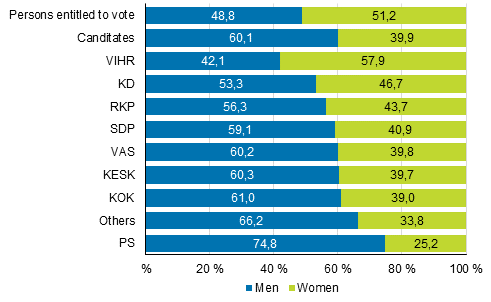
Women’s share of all candidates has remained at around 40 per cent throughout the 2000s. Among most parties, the share of female candidates has remained more or less on the same level. Only the Green League and the Left Alliance have clearly increased their share of female candidates in recent years. In the Green League, the share of female candidates has increased by seven percentage points from 2000 and in the Left Alliance by 5.6 percentage points. (Table 2)
Table 2. Women's proportion of persons entitled to vote and candidates (by party) in Municipal elections 2000 to 2017, %
| Party | 2000 | 2004 | 2008 | 2012 | 2017 |
| Persons entitled to vote | 51.8 | 51.6 | 51.5 | 51.4 | 51.2 |
| Candidates | 38.2 | 39.9 | 40.4 | 38.8 | 39.9 |
| Centre Party of Finland KESK |
38.2 | 39.7 | 40.3 | 39.8 | 39.7 |
| National Coalition Party KOK |
39.1 | 40.4 | 40.3 | 39.1 | 39.0 |
| Finns Party PS |
28.8 | 26.3 | 25.7 | 23.3 | 25.2 |
| Finnish Social Democratic Party SDP |
37.7 | 39.2 | 40.8 | 40.4 | 40.9 |
| Green League VIHR |
50.7 | 52.9 | 56.8 | 56.8 | 57.9 |
| Left Alliance VAS |
34.2 | 36.1 | 36.6 | 37.9 | 39.8 |
| Swedish People's Party in Finland RKP |
39.9 | 43.5 | 42.9 | 43.5 | 43.7 |
| Christian Democrats in Finland KD |
46.9 | 47.2 | 48.2 | 45.3 | 46.7 |
| Others | 32.0 | 34.6 | 33.6 | 32.8 | 33.8 |
The percentage of female candidates is highest in the region of Uusimaa (43.4%) and lowest in Central Ostrobothnia (35.7%). In addition to Uusimaa, only the regions of Varsinais-Suomi, Kanta-Häme and Ostrobothnia have more female candidates than average. (Figure 2)
Figure 2. Women’s share of candidates by region in Municipal elections 2017, %

More than one-half were also candidates in the 2012 Municipal elections
Of all the candidates nominated by the parties, over one-half of the candidates were also candidates in the 2012 Municipal elections. Of all candidates, 2.6 per cent were candidates for some other party in the previous elections and around 46 per cent of the candidates were new candidates. The Green League has the most new candidates, among whose candidates 60 per cent are new. Among the candidates of the Social Democratic Party, nearly 60 per cent were also nominated in the previous elections either as candidates for the Social Democratic Party or for some other party. In both elections, close on three per cent of candidates has changed parties. (Figure 3)
Around one-fifth of all the candidates are current councillors. The Centre Party has most current councillors on its list, around 28 per cent of the party's candidates and the Green League has the least, close on nine per cent. Altogether 162 of the candidates are Members of Parliament.
Figure 3. Share of candidates nominated in the 2012 election and new candidates by party in the Municipal elections 2017, %
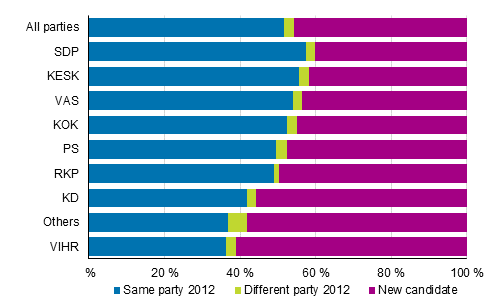
1.3. Age structure
Candidates grow older year by yearThe average age of the candidates is now almost one year higher than in the previous elections and around 3.6 years older than the candidates in 2000. Female candidates are around three years younger than male candidates. The average age of male candidates is now 50.7 years and that of female candidates 47.8. Female candidates are, on average, four years younger than women entitles to vote, whereas male candidates two years older than men entitled to vote. The average age of persons entitled to vote has risen by close on one year since the previous elections and by nearly three years from 2000. On the day of the election, the average age of persons entitled to vote is now 48.9 for men and 51.5 for women. (Table 3)
The sex and age structure of candidates is very different from that of persons entitled to vote (Figures 4 and 5). The age pyramid of neither group is no longer a pyramid as the name indicates: the age structure of persons entitled to vote rather resembles a tower and that of candidates a one sided gyroscope, from which the missing of the youngest and oldest age groups as well as the dominance of men are visible. Most male candidates represent the age group of those aged 50 to 64 and most female candidates the age group of those aged 40 to 54.
Figure 4. Age distributions and average age of persons entitled to vote by sex in Municipal elections 2017, %
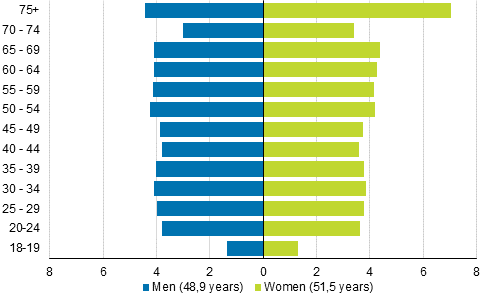
Figure 5. Age distributions and average age of candidates by sex in Municipal elections 2017, %
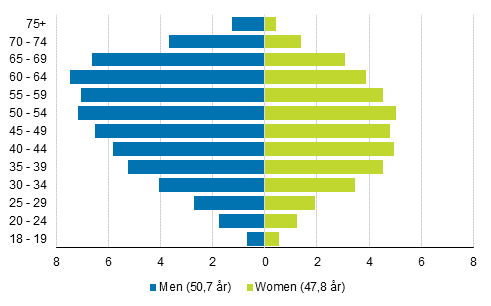
Examined by party, the Christian Democrats has the oldest candidates: Nearly 40 per cent of their candidates are aged 60 or over and the average age is 52.2 years. The Green League has the youngest candidates. Almost 45 per cent of them are aged under 40, and the average age of the candidates is 43.8 years. Around 29 per cent of all candidates are aged under 40 and around 31 per cent are aged 60 or over. (Figure 6, Table 3)
Figure 6. Persons entitled to vote and candidates (by party) by age group in Municipal elections 2017, %

Table 3. Average age of candidates by party in Municipal elections 2017
| Candidates | |||
| Total | Men | Women | |
| Persons entitled to vote | 50.3 | 48.9 | 51.5 |
| Candidates | 49.5 | 50.7 | 47.8 |
| Centre Party of Finland KESK |
49.5 | 50.9 | 47.5 |
| National Coalition Party KOK |
49.0 | 49.8 | 47.6 |
| Finns Party PS |
49.8 | 50.4 | 47.9 |
| Finnish Social Democratic Party SDP |
51.4 | 52.7 | 49.7 |
| Green League VIHR |
43.8 | 44.6 | 43.1 |
| Left Alliance VAS |
50.4 | 51.9 | 48.2 |
| Swedish People's Party in Finland RKP |
47.9 | 49.2 | 46.2 |
| Christian Democrats in Finland KD |
52.2 | 52.4 | 51.9 |
| Others | 48.9 | 49.7 | 47.2 |
Altogether 0.9 per cent of men and 0.6 per cent of women are nominated as candidates. In all age groups, fewer women are nominated than men. The share of candidates of the age group raises sharply for women to about the age of 40 and for men to the age of 50. At about the age of 40 women’s participation rate is only slightly lower than men’s but the difference grows after that. While women’s participation rate makes a downturn after the age of 40, men’s participation rate only drops at the age of 70 to the same level as for 40-year-old men.
The proportion of male candidates per age group is at its highest in ages 58 to 64, when around 1.4 to 1.5 per cent of each 1-year age group are candidates. Among women, most stand as candidates between the ages 40 to 50, 0.9 to 1.1 per cent of the age group. (Figure 7)
Figure 7. Share of candidates in the age group by sex in Municipal elections 2017, %
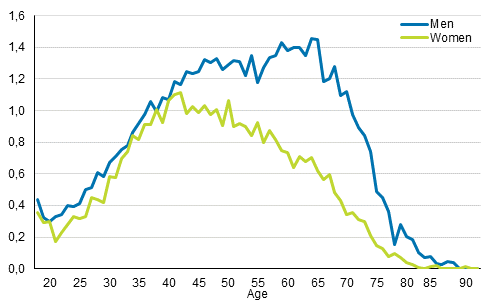
In small municipalities, Centre Party candidates in the municipalities
The Centre Party candidates dominate in small municipalities measured by population with fewer than 20,000 inhabitants. In municipalities with fewer than 5,000 inhabitants as much as 40 per cent of all candidates were nominated by the Centre Party. In municipalities of this size category, the Social Democratic Party and the National Coalition Party have nominated the second and third most candidates. In large municipalities with over 100,000 inhabitants the proportion of the Centre Party is slightly over ten per cent of all candidates. (Table 4)
In larger municipalities no party reaches as large a share of the candidates as the Centre Party does in small municipalities. In municipalities with 20,000 to 99,999 inhabitants, the Social Democratic Party’s share of candidates is good one-fifth and the National Coalition Party’s close on one-fifth.
In the largest municipalities with over 100,000 inhabitants the party distribution of candidates is considerably more even: the Coalition Party and the Social Democratic Party have nominated the most candidates, that is, both parties have a proportion of 15.5 per cent. Large cities also have more than average candidates from the Green League, the Left Alliance and the Communist Party of Finland. The share of the Finns Party candidates does not vary much by the size of the municipality.
Table 4. Party distribution of candidates by size of municipality in Municipal elections 2017, %
| Party | Total | Size category of municipality (population at the end of 2016) | ||||||
| - 4,999 | 5,000 - 9,999 | 10,000 - 19,999 | 20,000 - 49,999 | 50,000 - 99,999 | 100,000+ | |||
| Candidates | 100.0 | 100.0 | 100.0 | 100.0 | 100.0 | 100.0 | 100.0 | |
| Centre Party of Finland KESK |
22.2 | 40.0 | 28.5 | 23.0 | 15.4 | 15.5 | 10.5 | |
| National Coalition Party KOK |
17.1 | 15.0 | 16.1 | 17.9 | 18.6 | 20.0 | 15.5 | |
| Finns Party PS |
11.4 | 13.3 | 10.0 | 12.3 | 11.0 | 10.2 | 11.6 | |
| Finnish Social Democratic Party SDP |
18.2 | 14.2 | 17.6 | 19.1 | 21.8 | 21.8 | 15.5 | |
| Green League VIHR |
7.7 | 2.4 | 4.1 | 5.7 | 9.9 | 10.7 | 13.9 | |
| Left Alliance VAS |
9.5 | 6.0 | 9.2 | 8.1 | 11.5 | 8.8 | 12.7 | |
| Swedish People's Party in Finland RKP |
3.9 | 1.3 | 5.8 | 5.5 | 2.6 | 3.5 | 4.7 | |
| Christian Democrats in Finland KD |
5.9 | 3.6 | 4.8 | 6.1 | 6.2 | 6.7 | 7.9 | |
| Others | 4.0 | 4.4 | 3.8 | 2.2 | 2.9 | 2.9 | 7.6 | |
1.4. Foreign background
Good two per cent of candidates are foreign-language speakersThe language distribution among the candidates mirrors, by and large, the language distribution of the population in the regions. The proportion of Swedish-speaking candidates (5.6%) slightly exceeds their proportion of persons entitled to vote (4.7%). Swedish-speaking people are more active in the region of Uusimaa, where their proportion of the candidates is 13.4 per cent and that of the persons entitled to vote is 8.0 per cent.
In all, 5.7 per cent of all persons entitled to vote speak another language than Finland's national languages. Considerably fewer of the candidates, just 2.2 per cent are foreign-language speakers. The share of foreign-language speakers among candidates has, however, grown slightly from the 2012 elections when the share of foreign-language speaking candidates of all candidates was 1.8 per cent.
Among all candidates, the under-representation of foreign-language speakers is 3.5 percentage points. This means that there are fewer foreign-language speaking candidates than foreign-language speaking persons entitled to vote. The under-representation is highest in areas where the population share of foreign-language speakers is largest, i.e. in Uusimaa - especially in the Greater Helsinki region - and in Varsinais-Suomi. In Uusimaa, the share of foreign-language speakers is 7.1 and in Varsinais-Suomi 3.7 percentage points lower than among persons entitled to vote. (Table 5)
Of national language speakers, there are more Sami speakers as candidates than average. Of Sami speakers entitled to vote, 2.5 per cent stand as candidates. Of all persons entitled to vote, on average, 0.8 per cent are candidates. (Table 6)
Table 5. Persons entitled to vote and candidates by native language by region in Municipal elections 2017, %
| Region | Persons entitled to vote |
Candidates | ||||
| Finnish/ Sami |
Swedish | Other language |
Finnish/ Sami |
Swedish | Other language |
|
| MAINLAND FINLAND |
89.6 | 4.7 | 5.7 | 92.2 | 5.6 | 2.2 |
| Uusimaa | 81.1 | 8.0 | 10.9 | 82.8 | 13.4 | 3.8 |
| - Greater Helsinki region |
80.9 | 5.6 | 13.5 | 82.9 | 11.6 | 5.5 |
| Varsinais-Suomi | 88.7 | 5.7 | 5.7 | 91.1 | 6.9 | 2.0 |
| Satakunta | 96.9 | 0.3 | 2.7 | 98.5 | 0.3 | 1.2 |
| Kanta-Häme | 96.3 | 0.4 | 3.4 | 98.7 | 0.4 | 0.9 |
| Pirkanmaa | 95.7 | 0.4 | 4.0 | 98.1 | 0.3 | 1.6 |
| Päijät-Häme | 95.6 | 0.3 | 4.1 | 98.3 | 0.2 | 1.5 |
| Kymenlaakso | 94.2 | 0.8 | 5.0 | 95.7 | 1.3 | 3.0 |
| South Karelia | 94.8 | 0.2 | 5.0 | 96.7 | 0.0 | 3.3 |
| Etelä Savo | 97.3 | 0.2 | 2.6 | 98.0 | 0.0 | 2.0 |
| Pohjois Savo | 97.5 | 0.1 | 2.4 | 97.9 | 0.3 | 1.8 |
| North Karelia | 96.8 | 0.1 | 3.1 | 97.9 | 0.2 | 1.9 |
| Central Finland | 97.1 | 0.2 | 2.7 | 98.1 | 0.0 | 1.9 |
| South Ostrobothnia |
97.7 | 0.3 | 1.9 | 98.1 | 0.3 | 1.6 |
| Ostrobothnia | 45.5 | 49.5 | 5.1 | 44.4 | 51.7 | 3.9 |
| Central Ostrobothnia |
88.5 | 9.2 | 2.3 | 89.9 | 8.6 | 1.5 |
| North Ostrobothnia |
97.6 | 0.2 | 2.2 | 98.5 | 0.4 | 1.1 |
| Kainuu | 97.7 | 0.1 | 2.2 | 97.9 | 0.2 | 1.9 |
| Lapland | 97.6 | 0.2 | 2.2 | 98.4 | 0.2 | 1.4 |
Foreign-language speakers are considerably less often candidates. Of the candidates, 727 are foreign-language speakers. It is 0.3 per cent of the foreign-language speakers entitled to vote. The largest foreign-language speaking group among candidates is Russian speakers, 164 candidates, and the second largest is Estonian speakers, 72 candidates. (Table 6)
The Green League has the most foreign-language speaking candidates, 4.2 per cent of candidates and Christian Democrats has the second most, 3.4 per cent. The Centre Party has the lowest share of foreign-language speaking candidates, 1.3 per cent. (Figure 8)
Table 6. Persons entitled to vote and candidates by native language, largest language groups specified, in Municipal elections 2017, %
| Language | Persons entitled to vote |
Candidates | |
| Quantity | % of persons entitled to vote | ||
| All languages in total | 4,390,971 | 33,607 | 0.8 |
| Finnish | 3,930,811 | 30,965 | 0.8 |
| Swedish | 208,424 | 1,877 | 0.9 |
| Sami | 1,458 | 36 | 2.5 |
| Foreign-language speakers in total. |
250,278 | 727 | 0.3 |
| Russian | 57,531 | 164 | 0.3 |
| Estonian | 39,122 | 72 | 0.2 |
| Arabic | 10,489 | 44 | 0.4 |
| English | 14,058 | 40 | 0.3 |
| Kurdish | 8,057 | 40 | 0.5 |
| Turkish | 5,380 | 39 | 0.7 |
| Somali | 10,199 | 31 | 0.3 |
| Persian | 6,267 | 22 | 0.4 |
| Spanish | 5,969 | 21 | 0.4 |
| German | 5,425 | 21 | 0.4 |
| Bosnian | 1,476 | 16 | 1.1 |
| Albanian | 3,228 | 14 | 0.4 |
| French | 6,013 | 12 | 0.2 |
| Hungarian | 2,383 | 12 | 0.5 |
| Dutch | 1,442 | 12 | 0.8 |
| Portuguese | 1,907 | 11 | 0.6 |
Figure 8. Foreign-language speakers' share of persons entitled to vote and candidates (by party) in Municipal elections 2017, %
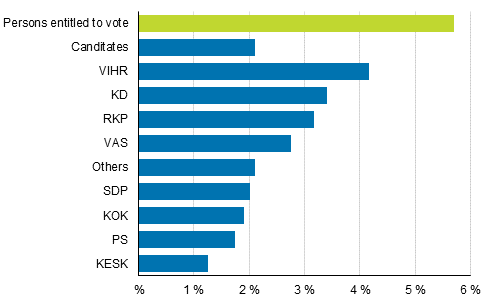
Candidates of foreign background still relatively rare
The foreign background of the population can also be examined by the person's origin. Of the persons entitled to vote, 94.1 and of candidates 97.8 per cent are of Finnish background, that is persons of whose parents at least one was born in Finland. Thus, close on six per cent of persons entitled to vote and good two per cent of candidates are of foreign background. The share of persons with foreign background among persons entitled to vote has grown more than among candidates since 2008. (Table 7)
Second generation immigrants, or those who were themselves born in Finland, but whose parents were born abroad, are still fairly few among both persons entitled to vote (0.2 %) and candidates (0.1 %). First generation immigrants (the person and parents both born abroad) are clearly under-represented among the candidates. Of all persons entitled to vote, 5.7 per cent belong to this group, while this is so for only 2.2 per cent of the candidates.
Table 7. Share of persons with foreign background (persons whose parents were born abroad) among candidates in Municipal elections 2017, %
| Persons entitled to vote | Candidates | |||||
| Persons | % | Persons | % | |||
| 2008 | ||||||
| Total | 4,196,522 | 100.0 | 38,505 | 100.0 | ||
| Persons with Finnish background | 4,061,481 | 96.8 | 37,929 | 98.5 | ||
| Parents born abroad, person in Finland | 3,212 | 0.1 | 30 | 0.1 | ||
| Parents born abroad, person born abroad | 131,829 | 3.1 | 546 | 1.4 | ||
| 2012 | ||||||
| Total | 4,303,061 | 100.0 | 37,124 | 100.0 | ||
| Persons with Finnish background | 4,111,553 | 95.6 | 36,402 | 98.1 | ||
| Parents born abroad, person in Finland | 5,086 | 0.1 | 31 | 0.1 | ||
| Parents born abroad, person born abroad | 186,422 | 4.3 | 691 | 1.9 | ||
| 2017 | ||||||
| Total | 4,394,748 | 100.0 | 33,618 | 100.0 | ||
| Persons with Finnish background | 4,135,837 | 94.1 | 32,862 | 97.8 | ||
| Parents born abroad, person in Finland | 9,512 | 0.2 | 23 | 0.1 | ||
| Parents born abroad, person born abroad | 249,399 | 5.7 | 733 | 2.2 | ||
Examined by party, the number of candidates with foreign background is highest in the Swedish People's Party, 4.2 per cent of the candidates, and lowest in the Centre Party (1.2 %) and the Coalition Party (1.8 %). The Green League, the Christian Democrats, the Communist Party, and the Left Alliance also have more than average candidates with foreign background. (Figure 9)
Figure 9. Proportion of persons with foreign background (persons whose both parents were born abroad) by party in Municipal elections 2017, %
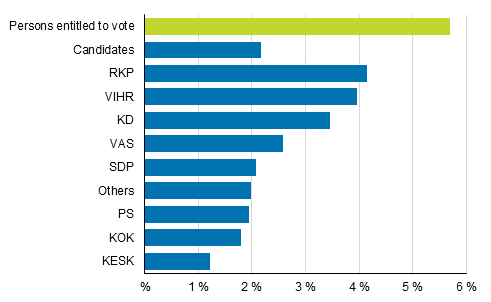
Number of candidates with dual citizenship 462
There are citizens from over 60 different countries among the candidates even though the share of foreign citizens among all candidates is under one per cent. Four per cent of all persons entitled to vote are foreign citizens. Of the candidates, 263 persons are foreign citizens. The biggest nationality group is Estonian with 50 candidates, the second largest are Swedish with 30 and Russian with 28 candidates.
There are 462 candidates that are Finnish citizens with citizenship in another country as well. They represent 1.4 per cent of all candidates. Of all persons entitled to vote, there are nearly 75,000 persons with dual citizenship or 1.7 per cent. Among the candidates the most common second citizenship is Russian, 105 persons and Swedish, 58 persons.
Table 8. Persons entitled to vote and candidates by nationality in Municipal elections 2017
| Nationality | Persons entitled to vote | Candidates | ||||
| 1st nationality | 2nd nationality | 1st nationality | 2nd nationality | |||
| All nationalities | 4,391,009 | 74,733 | 33,618 | 462 | ||
| Finnish citizens | 4,217,752 | .. | 33,355 | .. | ||
| Foreign citizens | 173,257 | 74,733 | 263 | 462 | ||
| Russian | 22,637 | 22,266 | 28 | 105 | ||
| Swedish | 6,293 | 4,309 | 30 | 58 | ||
| Turkish | 3,383 | 2,254 | .. | 37 | ||
| Iranian | 2,101 | 3,100 | .. | 25 | ||
| Estonian | 40,290 | 3,260 | 50 | 19 | ||
| German | 3,763 | 1,595 | .. | 17 | ||
| Afghan | 2,262 | 1,885 | .. | 10 | ||
| Dutch | 1,249 | 303 | 10 | .. | ||
1.5. Educational level
Green League candidates have the highest level of educationAs regards education, candidates differ clearly from persons entitled to vote. Nearly 90 per cent of the candidates have completed post-comprehensive level qualifications while 73 per cent of those entitled to vote have done so. This is partially explained by the fact that there are very few representatives of the oldest age groups among the candidates whose educational level is usually lower than for younger persons. Of persons entitled to vote, 31 per cent have at least lowest level tertiary education and of the candidates this is so for 46 per cent. (Figure 10)
The educational level is highest for the Green League candidates. More than one-half of them have tertiary level qualifications, while this is so for one-third of all candidates and around one fifth of all persons entitled to vote. Swedish People's Party, Coalition Party and Christian Democrat candidates also have more tertiary level qualifications than average for the candidates.
Figure 10. Persons entitled to vote and candidates (by party) by educational level in Municipal elections 2017, %
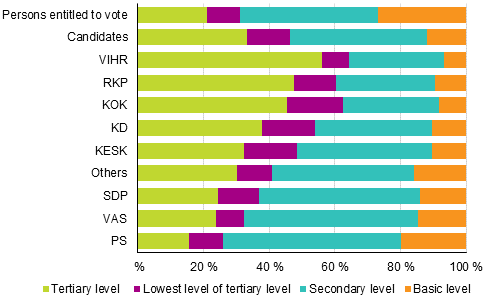
The educational level of the candidates reflects the differences in the educational structure of different areas. In the region of Uusimaa, the proportion of highly educated is higher than in the rest of the country both among the persons entitled to vote and the candidates (Figure 11). In Uusimaa, over 40 per cent of candidates have tertiary level qualifications. In other regions, the share of candidates with tertiary level qualifications is below 35 per cent.
Figure 11. Proportion of persons with tertiary level qualifications among persons entitled to vote and candidates by region in Municipal elections 2017, %
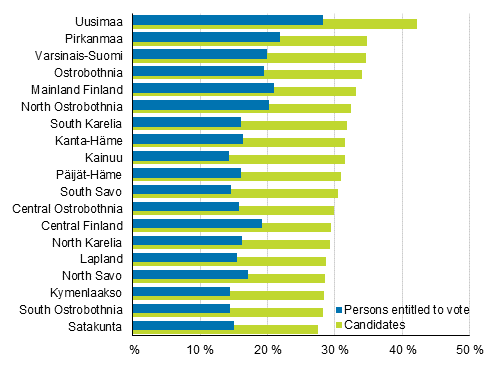
1.6. Labour market position
Almost one-fifth of candidates are pensioner s
Sixty-eight per cent of the candidates are employed, and the proportion of unemployed persons is the same as among persons entitled to vote, slightly over eight per cent. In turn, there are clearly fewer pensioners among the candidates, only close on 17 per cent. When looking at working-age population (aged 18 to 64), 78 per cent of the candidates are employed, while the proportion of employed persons is ten percentage points lower among all persons entitled to vote. Distinctly more of the persons entitled to vote of this age are students and other inactive population than among the candidates. (Figure 12)
Around one-half of persons entitled to vote, are working, eight per cent are unemployed and close on 30 per cent are pensioners. Seven per cent of persons entitled to vote are studying and around four per cent are otherwise in the inactive population.
The number of employed persons is highest among the Coalition Party, Swedish People's Party and Centre Party candidates, of whom around 75 per cent are working. In these parties unemployment is rarer than average. The Green League has most students, as nine per cent of their candidates are students. The Christian Democrats, Left Alliance and Finns Party have the most retired candidates, as over one-fifth of their candidates are pensioners.
Figure 12. Persons entitled to vote and candidates (by party) by main type of activity in Municipal elections 2017, %

Candidates’ employment rate 78 per cent
The employment rate is calculated as the ratio of employed persons aged 18 to 64 to the population of the same age. Of all candidates aged 18 to 64, altogether 78 per cent are employed. The employment rate of persons entitled to vote is ten percentage points lower. The employment rates of the candidates resemble the general employment rates in the regions. Where the employment rate of the total population is high, the employment rate of the candidates is also at a high level there. Ostrobothnia has the highest employment rate of total population, 73.5 per cent, and there over 83 per cent of the candidates are working. Correspondingly in North Karelia where the general employment rate is lowest in the country, the employment rate of candidates is also lower than the average. (Figure 13, Table 9)
The employment rates of the candidates are closest to those entitled to vote in Uusimaa and Central Finland, where the employment rate of the candidates is 7.8 percentage points higher than that of persons entitled to vote. The difference between employment rates is largest in Päijät-Häme, that is, 13.6 percentage points. There the employment rate of the candidates is 79.5 per cent and that of persons entitled to vote 65.8 per cent.
Figure 13. Employment rate of persons entitled to vote and candidates (aged 18 to 64) by region in Municipal elections 2017, %
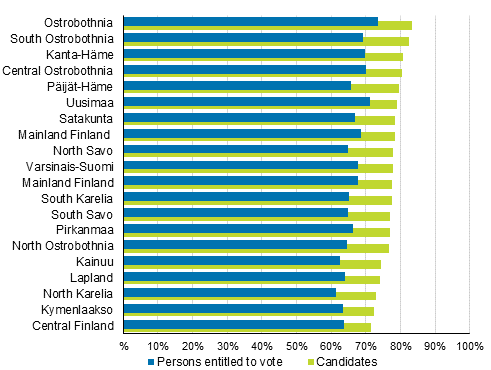
Table 9. Employment rate of persons entitled to vote and candidates (aged 18 to 64) by region in Municipal elections 2017, %
| Region | Both sexes | Men | Women | |||
| Persons entitled to vote |
Candidates | Persons entitled to vote |
Candidates | Persons entitled to vote |
Candidates | |
| Mainland Finalnd |
67.8 | 77.6 | 66.2 | 76.8 | 69.3 | 78.7 |
| Uusimaa | 71.3 | 79.1 | 70.3 | 79.6 | 72.3 | 78.4 |
| Varsinais-Suomi | 67.8 | 77.8 | 66.1 | 76.3 | 69.4 | 79.7 |
| Satakunta | 66.9 | 78.6 | 65.3 | 77.5 | 68.7 | 80.2 |
| Kanta-Häme | 69.8 | 80.9 | 68.6 | 79.2 | 71.0 | 83.1 |
| Pirkanmaa | 66.4 | 77.0 | 64.9 | 76.4 | 68.1 | 77.8 |
| Päijät-Häme | 65.8 | 79.5 | 64.6 | 78.3 | 67.1 | 81.3 |
| Kymenlaakso | 63.5 | 72.4 | 61.3 | 72.7 | 65.8 | 71.9 |
| South Karelia |
65.1 | 77.5 | 62.9 | 76.9 | 67.5 | 78.4 |
| Etelä Savo |
64.8 | 77.1 | 62.0 | 77.7 | 67.8 | 76.3 |
| Pohjois Savo |
64.8 | 77.8 | 62.6 | 77.1 | 67.1 | 78.7 |
| North Karelia |
61.4 | 73.0 | 58.7 | 69.8 | 64.3 | 78.2 |
| Central Finland |
63.8 | 71.5 | 62.4 | 71,0 | 65.1 | 72.3 |
| South Ostrobothnia |
69.1 | 82.5 | 67.6 | 81.8 | 70.6 | 83.7 |
| Ostrobothnia | 73.5 | 83.2 | 72.3 | 82.0 | 74.8 | 84.8 |
| Central Ostrobothnia |
70.2 | 80.3 | 69.8 | 80.5 | 70.5 | 80.0 |
| North Ostrobothnia |
64.5 | 76.7 | 63.4 | 74.9 | 65.6 | 79.2 |
| Kainuu | 62.6 | 74.3 | 58.9 | 73.9 | 66.7 | 74.8 |
| Lapland | 63.9 | 74.3 | 61.0 | 72.4 | 67.0 | 76.9 |
Of all employed candidates nearly 30 per cent and of employed persons entitled to vote around 20 per cent are upper-level employees. Most salaried employees, nearly one-half of employed candidates, are found in the Green League. Also in the Swedish People’s Party and the Coalition Party, nearly 40 per cent of candidates are upper-level employees. The number of salaried employees is lowest among the candidates of the Finns Party (13.5%) and the Left Alliance (19.6%). (Figure 14)
Of all employed candidates, 16.4 per cent are self-employed and of all persons entitled to vote 10.5 per cent. The most self-employed persons are found among Centre Party candidates (28.4%) of whom more than one-half are farmers and forestry entrepreneurs. Among the Coalition Party candidates good one-fifth are also self-employed, however, focusing more on other self-employed persons than farmers and forestry entrepreneurs. The proportion of workers is highest among the Finns Party and Left Alliance candidates, good one-third, and among the Social Democrats, about 31 per cent.
Figure 14. Employed persons entitled to vote and candidates (by party) by socio-economic position in the Municipal elections 2017, %
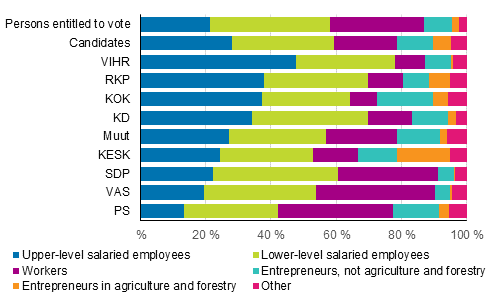
Public sector employs candidates more than persons entitled to vote
Of the candidates 78 per cent are employed. Around 46 per cent of them are private sector wage and salary earners, 16 per cent are self-employed, 6.5 per cent work for central government and 31 per cent for local government. Employer type varies significantly by party. The share of private sector wage and salary earners is highest among the Left Alliance, Finns Party and Social Democratic Party candidates, of whom more than one-half work in the private sector. The lowest proportion of private sector wage and salary earners is found among the Centre Party candidates (36%).
Thirty per cent of the Centre Party candidates are entrepreneurs, the majority of whom work in agriculture. The Social Democratic Party has the least self-employed persons (5.2%). The public sector employs the most Green League candidates: 36 per cent of the candidates receive their pay from local government and 9.4 per cent from central government. The next highest proportion of public sector employees is found among the Social Democrats, of whom 39 per cent are employed by local and 5.5 per cent by central government. The share of public sector candidates is lowest for the Finns Party of whom fewer than 30 per cent work in the public sector. (Figure 15)
Figure 15. Persons entitled to vote and candidates (by party) by employer sector in Municipal elections 2017, %
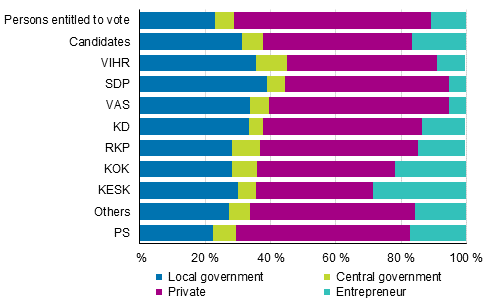
The public sector employs candidates most in the largest municipalities with over 50,000 inhabitants. In these municipalities, around 40 per cent of the candidates or even more work in the local or central government sector. In these municipalities, especially the share of those working in the central government sector is higher than in smaller municipalities. In small municipalities with fewer than 5,000 inhabitants, the share of self-employed persons among employed candidates is nearly one-quarter. (Table 10)
Table 10. Candidates by employer sector and size of municipality in Municipal elections 2017, %
| Size category of municipality | Total | Public sector | Private sector |
Self-employed persons | ||
| Total | Local government | Central government | ||||
| Persons entitled to vote | ||||||
| Total | 100.0 | 28.9 | 23.1 | 5.8 | 60.4 | 10.5 |
| -1,999 | 100.0 | 30.1 | 26.9 | 3.2 | 46.7 | 22.8 |
| 2,000-4,999 | 100.0 | 29.8 | 26.7 | 3.2 | 49.2 | 20.7 |
| 5,000-9,999 | 100.0 | 29.4 | 25.5 | 3.9 | 54.2 | 16.2 |
| 10,000-19,999 | 100.0 | 28.5 | 24.7 | 3.8 | 57.9 | 13.5 |
| 20,000-49,999 | 100.0 | 27.9 | 23.4 | 4.5 | 61.6 | 10.3 |
| 50,000-99,999 | 100.0 | 32.5 | 26.3 | 6.2 | 57.9 | 9.5 |
| 100,000+ | 100.0 | 27.9 | 20.3 | 7.7 | 64.6 | 7.5 |
| Candidates | ||||||
| Total | 100.0 | 37.8 | 31.3 | 6.5 | 45.6 | 16.4 |
| -1,999 | 100.0 | 37.8 | 33.8 | 4.0 | 35.6 | 26.6 |
| 2,000-4,999 | 100.0 | 35.6 | 31.1 | 4.4 | 39.7 | 24.6 |
| 5,000-9,999 | 100.0 | 35.5 | 30.7 | 4.8 | 43.0 | 21.4 |
| 10,000-19,999 | 100.0 | 37.6 | 32.7 | 4.9 | 44.5 | 17.9 |
| 20,000-49,999 | 100.0 | 37.2 | 30.9 | 6.3 | 49.7 | 13.0 |
| 50,000-99,999 | 100.0 | 43.1 | 34.8 | 8.3 | 45.0 | 11.8 |
| 100,000+ | 100.0 | 39.7 | 28.6 | 11.1 | 51.7 | 8.4 |
1.7. Family status
Good one-third of candidates are parents of a family with childrenThe candidates also differ in their family status from the persons entitled to vote: considerably more (36%) of the candidates are parents of a family with children than among persons entitled to vote (23%) and fewer candidates live alone (18%) than among persons entitled to vote (25%). Fewer of the candidates are young people living at home. Differences in the family status are explained by the fact that the age structure of the candidates and persons entitled to vote differs from each other. Both the bottom and top ends of the age range are missing among the candidates. For a majority of those entitled to vote, children have already moved from home, while most candidates are at an age when children are still living at home. (Figure 16, Table 11)
The Green League has the most candidates that are parents of a family with children, close on 45 per cent. Among the Coalition Party and Centre Party candidates, nearly 40 per cent are parents of a family with children, The Left Alliance has the least candidates that still have children aged under 18 living at home. The Swedish People’s Party has the most young people aged under 25 still living at home (5.4%) and the Finns Party has the most persons living alone (24%) among their candidates.
Figure 16. Persons entitled to vote and candidates (by party) by family type in Municipal elections 2017, %
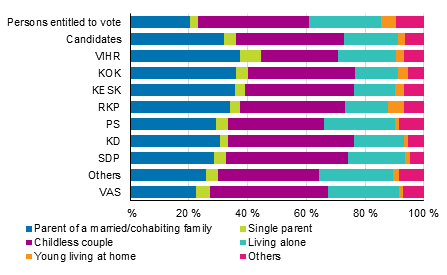
Table 11. Persons entitled to vote and candidates (by party) by family status in Municipal elections 2017, %
| Party | All total |
Families with children (aged under 18) |
Childless couple |
Living alone |
Youth living at home |
Other | |
| Parent of a married/cohabiting family |
Single- supporter household |
||||||
| Persons entitled to vote | 100.0 | 20.4 | 2.7 | 37.7 | 24.6 | 5.,3 | 9.3 |
| Candidates | 100.0 | 31.8 | 4.1 | 37.0 | 18.3 | 2.4 | 6.4 |
| Centre Party of Finland KESK |
100.0 | 35.8 | 3.3 | 37.2 | 14.0 | 2.9 | 6.8 |
| National Coalition Party KOK |
100.0 | 36.0 | 4.0 | 36.6 | 14.5 | 3.3 | 5.5 |
| Finns Party PS |
100.0 | 29.2 | 4.3 | 32.5 | 24.4 | 1.4 | 8.3 |
| Finnish Social Democratic Party SDP |
100.0 | 28.4 | 4.2 | 41.7 | 19.3 | 1.6 | 4.8 |
| Green League VIHR |
100.0 | 37.3 | 7.3 | 26.3 | 19.7 | 28 | 6.7 |
| Left Alliance VAS |
100.0 | 22.4 | 4.6 | 40.4 | 24.3 | 1.1 | 7.2 |
| Swedish People's Party in Finland RKP |
100.0 | 34.1 | 3.2 | 35.9 | 14.7 | 5.4 | 6.8 |
| Christian Democrats in Finland KD |
100.0 | 30.4 | 2.8 | 42.9 | 17.0 | 1.5 | 5.4 |
| Others | 100.0 | 25.8 | 4.1 | 34.5 | 24.9 | 2.0 | 8.6 |
1.8. Number of children
Candidates have more children than averageFamily status does not reveal how many of the candidates have or have had children of their own, because in older families, children may have already moved away from home and in family break-ups, children may live with their other parent. This can, however, be examined based on the number of children recorded in the Finnish Population Information System.
Candidates have more children than average. Of the candidates, 78 per cent have children of their own, whereas the corresponding figure for persons entitled to vote is 65 per cent. Children are the most numerous among the Christian Democrats, of whom 22 per cent have at least four children, and among the Centre Party candidates, of whom 17 per cent have four or more children. Large families are rarer for the Green League candidates (Figure 17).
In all, 35 per cent of the persons entitled to vote and 22 per cent of the candidates have never had children of their own. The proportion of childless candidates varies from 18 per cent for the Social Democrats to 30 per cent for the Green League.
Figure 17. Persons entitled to vote and candidates (by party) by number of children in Municipal elections 2017, %
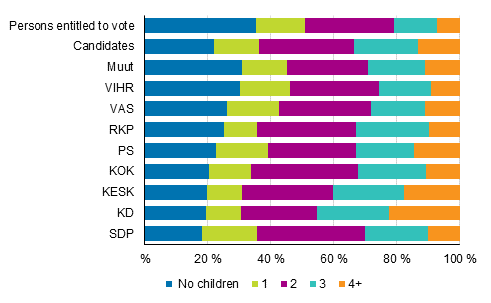
On average, the candidates have two children. All persons entitled to vote have an average of 1.5 children. The number of children is highest among the Christian Democrat candidates, i.e. 2.4 children and lowest among the Green League candidates, 1.6 children. Men entitled to vote have slightly fewer children than women, but there are not much of a difference between sexes among the candidates. (Table 12)
Table 12. Persons entitled to vote and candidates (by party) by number of children (on average) in Municipal elections 2017
| Party | Total | Males | Females |
| Persons entitled to vote | 1.5 | 1.4 | 1.6 |
| Candidates | 2.0 | 2.0 | 2.0 |
| Centre Party of Finland KESK |
2.3 | 2.4 | 2.3 |
| National Coalition Party KOK |
2.0 | 2.0 | 1.9 |
| Finns Party PS |
1.9 | 1.9 | 2.1 |
| Finnish Social Democratic Party SDP |
1.9 | 1.9 | 2.0 |
| Green League VIHR |
1.6 | 1.5 | 1.7 |
| Left Alliance VAS |
1.8 | 1.7 | 1.8 |
| Swedish People's Party in Finland RKP |
1.9 | 1.8 | 1.9 |
| Christian Democrats in Finland KD |
2.4 | 2.4 | 2.3 |
| Others | 1.7 | 1.7 | 1.8 |
1.9. Income level
Candidates’ income level higher than that of persons entitled to voteThe following examines the persons entitled to vote and the candidates by their disposable income. The income data derive from the latest taxation data from 2015. Disposable monetary income refers to the monetary income after taxes that consists of earned income, property income, and transfer income.
Candidates are more highly educated and a larger share of them are also working than among persons entitled to vote. This partly explains why their income level is also higher than that of persons entitled to vote. The median disposable income of persons entitled to vote was EUR 20,500 in 2015, while that of candidates was EUR 26,100. The candidates' disposable income is, on average, 27 per cent higher than of persons entitled to vote. Disposable income is highest in Uusimaa both for persons entitled to vote (EUR 22,900 per year) and for candidates (EUR 28,300 per year). (Figure 18, Table 13)
The income differential between the candidates and persons entitled to vote is largest in South Ostrobothnia, South Karelia and Ostrobothnia, where the median income of the candidates is over EUR 6,500 higher than that of persons entitled to vote. The income differential is smallest in Lapland, North Karelia, Uusimaa and Central Finland, under EUR 5,500.
Figure 18. Median disposable income (EUR per year) of persons entitled to vote and candidates by region in Municipal elections 2017
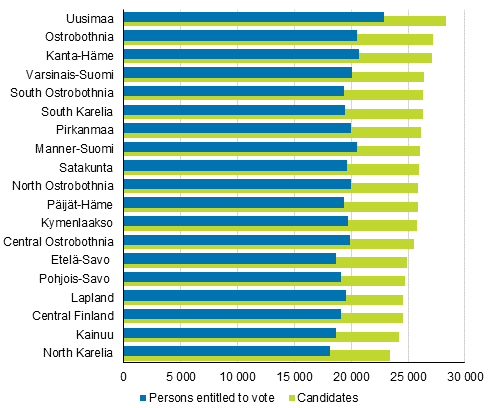
Table 13. Median disposable income (EUR per year) of persons entitled to vote and candidates by region in Municipal elections 2017, %
| Region | Persons entitled to vote |
Candidates | ||||
| Both sexes | Men | Women | Both sexes | Men | Women | |
| Mainland Finland |
20,503 | 22,131 | 19,293 | 26,076 | 26,586 | 25,450 |
| Uusimaa | 22,916 | 26,636 | 21,631 | 28,296 | 29,134 | 27,020 |
| Varsinais-Suomi | 20,061 | 21,634 | 18,913 | 26,420 | 26,719 | 26,080 |
| Satakunta | 19,605 | 21,541 | 18,114 | 25,987 | 27,058 | 24,781 |
| Kanta-Häme | 20,680 | 22,507 | 19,274 | 27,081 | 27,036 | 27,280 |
| Pirkanmaa | 19,951 | 21,736 | 18,686 | 26,151 | 26,846 | 25,416 |
| Päijät-Häme | 19,363 | 21,159 | 18,144 | 25,886 | 26,588 | 25,062 |
| Kymenlaakso | 19,741 | 21,861 | 18,155 | 25,794 | 26,730 | 24,607 |
| South Karelia |
19,490 | 21,524 | 18,009 | 26,291 | 28,001 | 24,248 |
| Etelä Savo |
18,649 | 19,698 | 17,757 | 24,926 | 25,411 | 24,222 |
| Pohjois Savo |
19,082 | 20,279 | 18,119 | 24,755 | 25,067 | 24,265 |
| North Karelia |
18,162 | 19,052 | 17,468 | 23,424 | 23,465 | 23,142 |
| Central Finland |
19,071 | 20,633 | 17,919 | 24,521 | 24,972 | 23,655 |
| South Ostrobothnia |
19,352 | 20,737 | 18,268 | 26,330 | 26,610 | 26,092 |
| Ostrobothnia | 20,507 | 22,662 | 18,794 | 27,192 | 28,217 | 26,154 |
| Central Ostrobothnia |
19,878 | 22,036 | 18,232 | 25,529 | 25,673 | 25,505 |
| North Ostrobothnia |
19,954 | 21,455 | 18,794 | 25,887 | 26,164 | 25,525 |
| Kainuu | 18,693 | 19,606 | 17,874 | 24,241 | 24,553 | 23,713 |
| Lapland | 19,510 | 20,538 | 18,717 | 24,536 | 24,816 | 24,091 |
The candidates’ income varies by party from EUR 31,200 in the Coalition Party to EUR 22,000 in the Finns Party. The median income of candidates from the Swedish People’s Party is EUR 29,500, EUR 26,900 for the Centre Party and EUR 26 600 for the Social Democratic Party. Compared with persons entitled to vote, the candidates of the Coalition Party have over EUR 10,000 more at their disposal per year. The candidates for the Finns Party are closest to persons entitled to vote in terms of their income level. Their annual disposable income is EUR 1,700 higher than that of persons entitled to vote. (Figure 19, Table 14)
Figure 19. Median disposable income (EUR) of persons entitled to vote and candidates (by party) in Municipal elections 2017
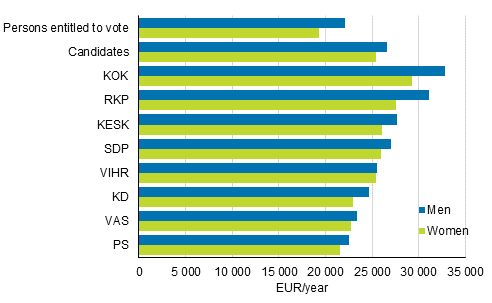
Table 14. Median disposable income (EUR per year) of persons entitled to vote and candidates (by party) in Municipal elections 2017
| Party | Median income (EUR/year) | ||
| Total | Men | Women | |
| Persons entitled to vote |
20,503 | 22,131 | 19,293 |
| Candidates | 26,076 | 26,586 | 25,450 |
| Centre Party of Finland KESK |
26,932 | 27,687 | 26,089 |
| National Coalition Party KOK |
31,190 | 32,789 | 29,328 |
| Finns Party PS |
22,225 | 22,534 | 21,550 |
| Finnish Social Democratic Party SDP |
26,552 | 26,974 | 25,943 |
| Green League VIHR |
25,478 | 25,557 | 25,450 |
| Left Alliance VAS |
23,102 | 23,410 | 22,750 |
| Swedish People's Party in Finland RKP |
29,483 | 31,130 | 27,585 |
| Christian Democrats in Finland KD |
23,610 | 24,668 | 23,002 |
| Others | 22,199 | 21,399 | 22,956 |
When the population entitled to vote is arranged according to income and divided into ten equal parts, the income deciles of the population entitled to vote are generated. Each of these has slightly under 440,000 persons. The highest income decile of the population entitled to vote has at least EUR 38,000 at their disposal and the lowest income decile at most EUR 8,250.
Of all candidates, 18 per cent belong to the highest income decile. Of the candidates, those representing the National Coalition Party and the Swedish People's Party in Finland belong to the higher end of the income distribution. Thirty-six per cent of the male candidates and 25 per cent of female candidates in the National Coalition Party belong to the highest income decile. Among the candidates of the Swedish People's Party, around 28 per cent of men and 19 per cent of women belong to the highest income decile. (Figure 20)
There are fewer women in the highest income decile both among persons entitled to vote and candidates. The biggest difference between sexes is found among the Swedish People's Party, the Coalition Party and the Centre Party candidates. In these parties, there are over ten percentage points more men in the highest income decile than women. The difference is smallest among Green League candidates where around three percentage points more men than women belong to the highest income decile.
Figure 20. Proportion of persons belonging to the highest income decile by party in Municipal elections 2017, %
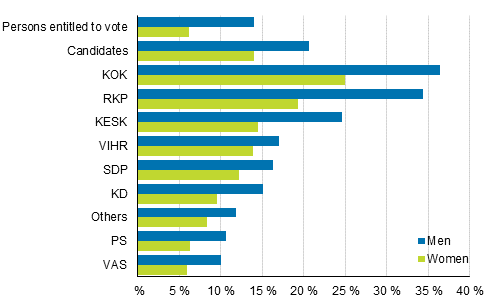
Around six per cent of candidates belong to the lowest income decile. Of the candidates of parties outside the Parliament and constituency associations, close on ten per cent belong to the lowest- income decile, and of the Swedish People's Party candidates, 8.9 per cent of men and 8.2 per cent of women. The Social Democrats have the least candidates belonging to the lowest income decile, only 2.6 per cent of female candidates and four per cent of male candidates. (Figure 21)
The share of men is also higher in the lowest income decile than that of women both among persons entitled to vote and candidates. Only among the Left Alliance and Green League candidates, more female candidates belong to the lowest income decile than male candidates. However, the difference between sexes is not as large as in the shares of those belonging to the highest income decile.
Figure 21. Proportion of persons belonging to the lowest income decile by party in Municipal elections 2017, %
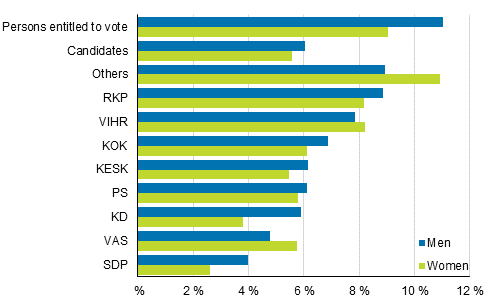
Source: Municipal Elections 2017, nomination of candidates and background analysis of candidates, Statistics Finland
Inquiries: Sami Fredriksson 029 551 2696, Kaija Ruotsalainen 029 551 3599, Jaana Asikainen 029 551 3506, vaalit@stat.fi
Director in charge: Jari Tarkoma
Updated 31.03.2017
Official Statistics of Finland (OSF):
Municipal elections [e-publication].
ISSN=2323-1114. Nomination of candidates and background analysis of candidates 2017,
1. Background analysis of candidates in the Municipal elections 2017
. Helsinki: Statistics Finland [referred: 20.1.2026].
Access method: http://stat.fi/til/kvaa/2017/01/kvaa_2017_01_2017-03-31_kat_001_en.html

